Abstract
Early basic research showed that increases in required response effort (or force) produced effects that resembled those produced by punishment. A recent study by Alling and Poling determined some subtle differences between the two behavior-change strategies, but also confirmed that increasing required effort is an effective response-reduction procedure with enduring effects. In this paper we summarize basic research on response effort and explore the role of effort in diverse applied areas including deceleration of aberrant behavior, attention deficit hyperactivity disorder, oral habits, health care appointment keeping, littering, indexes of functional disability, and problem solving. We conclude that renewed interest in response effort as an independent variable is justified because of its potent effects and because the political constraints imposed on punishment- and reinforcement-based procedures have yet to be imposed on procedures that entail manipulations of response effort.
Keywords: response effort, response force, response requirement, punishment
Full text
PDF
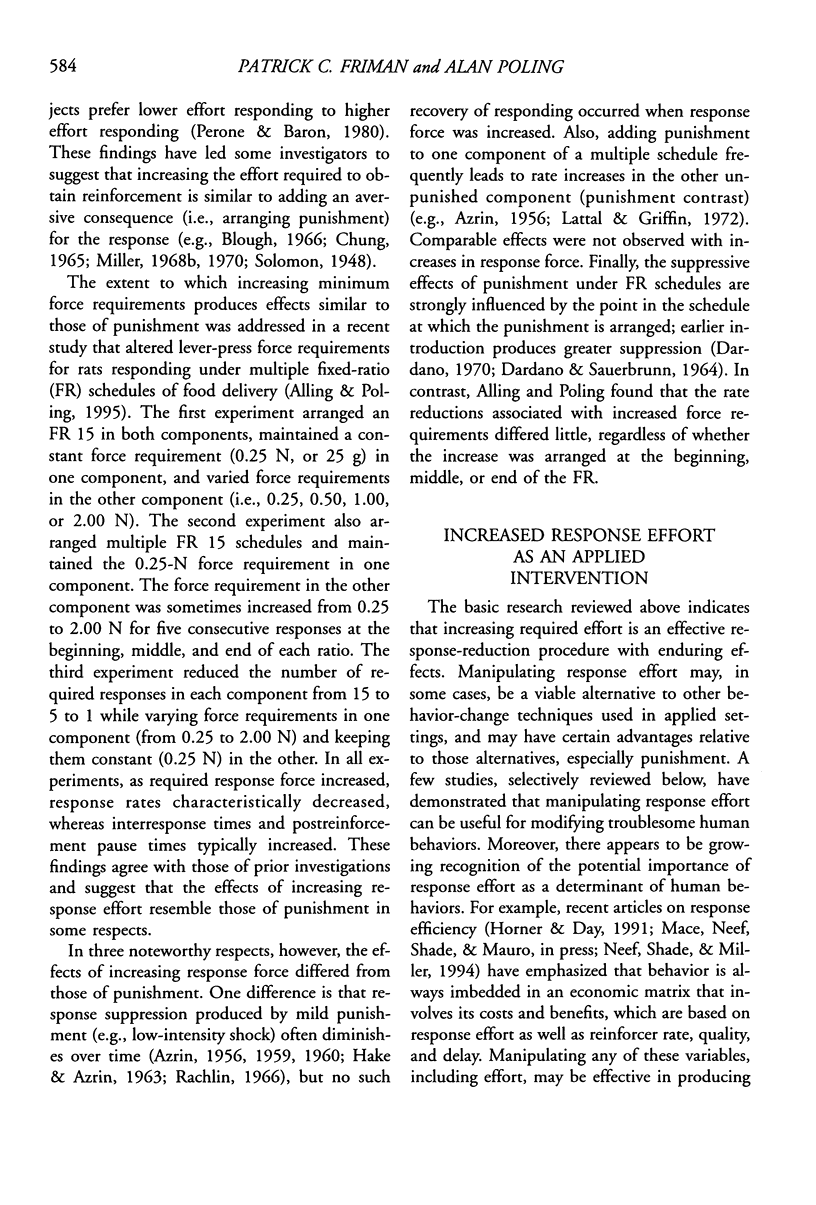
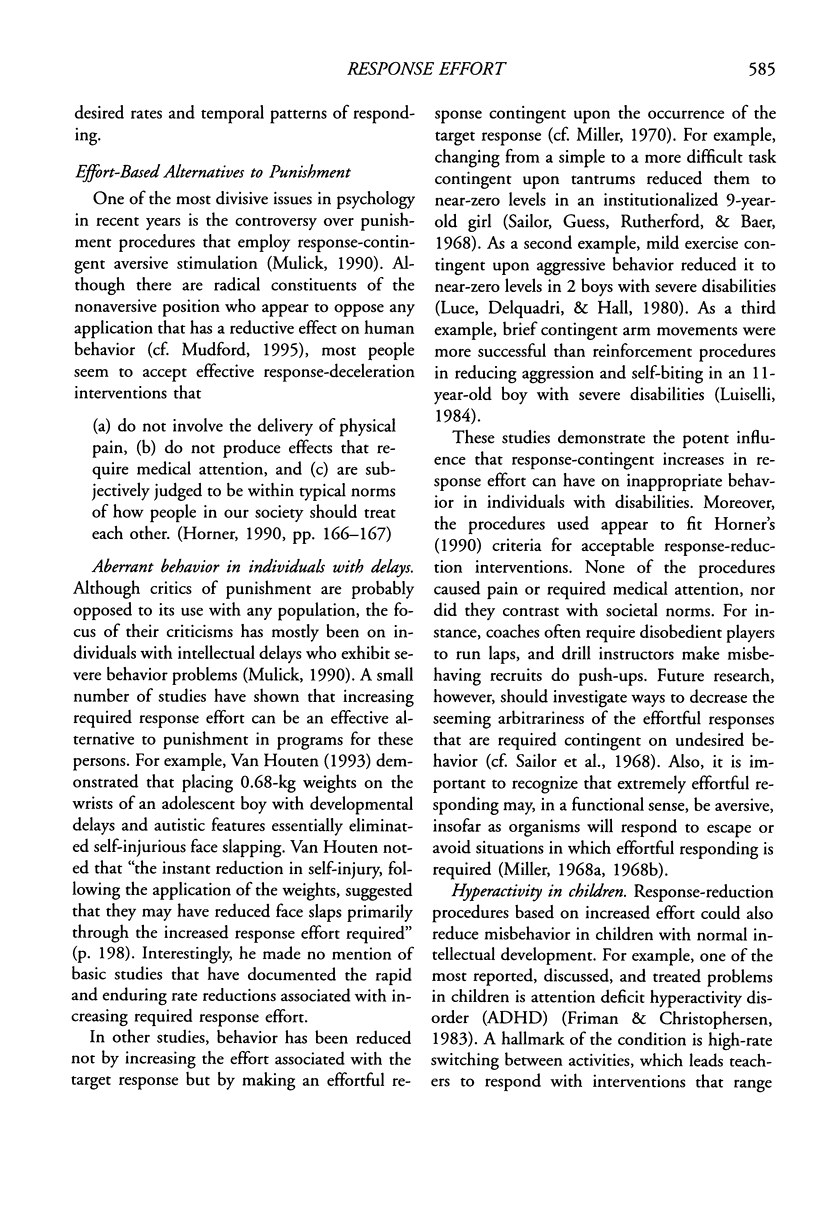


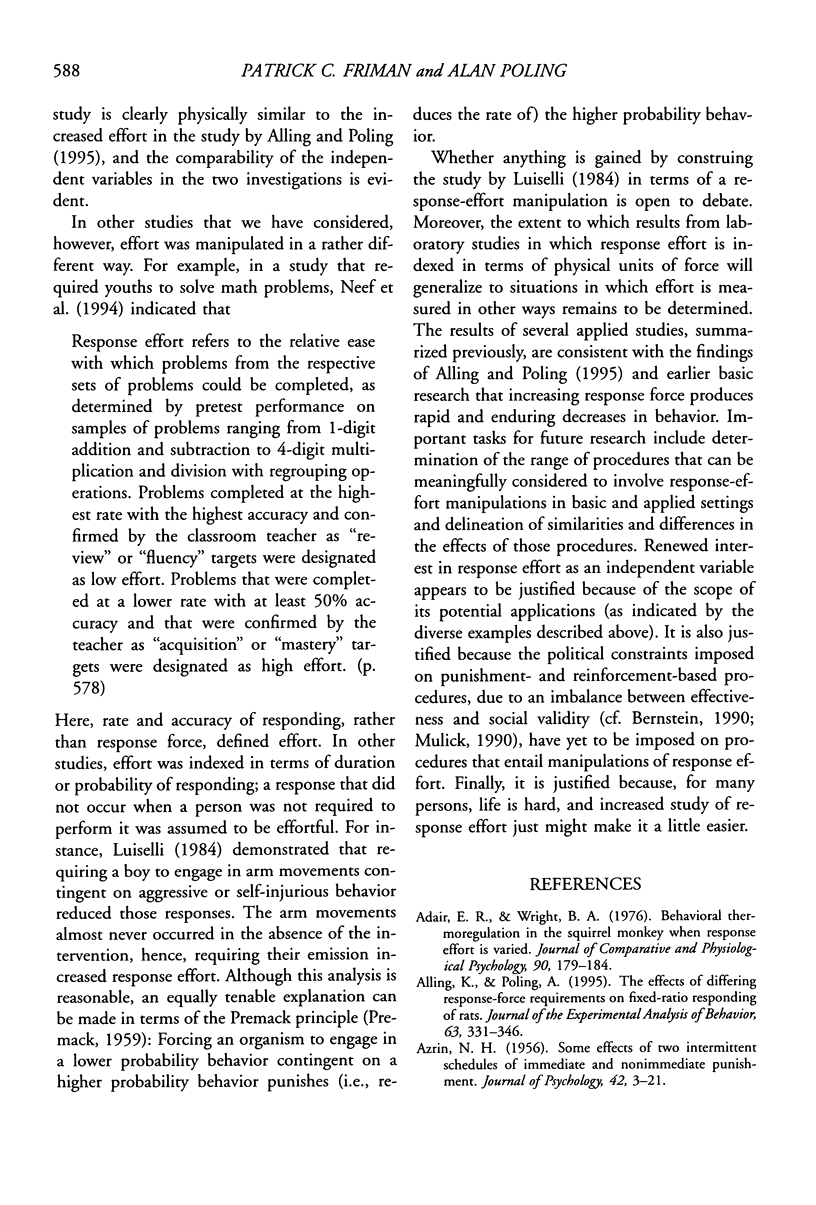
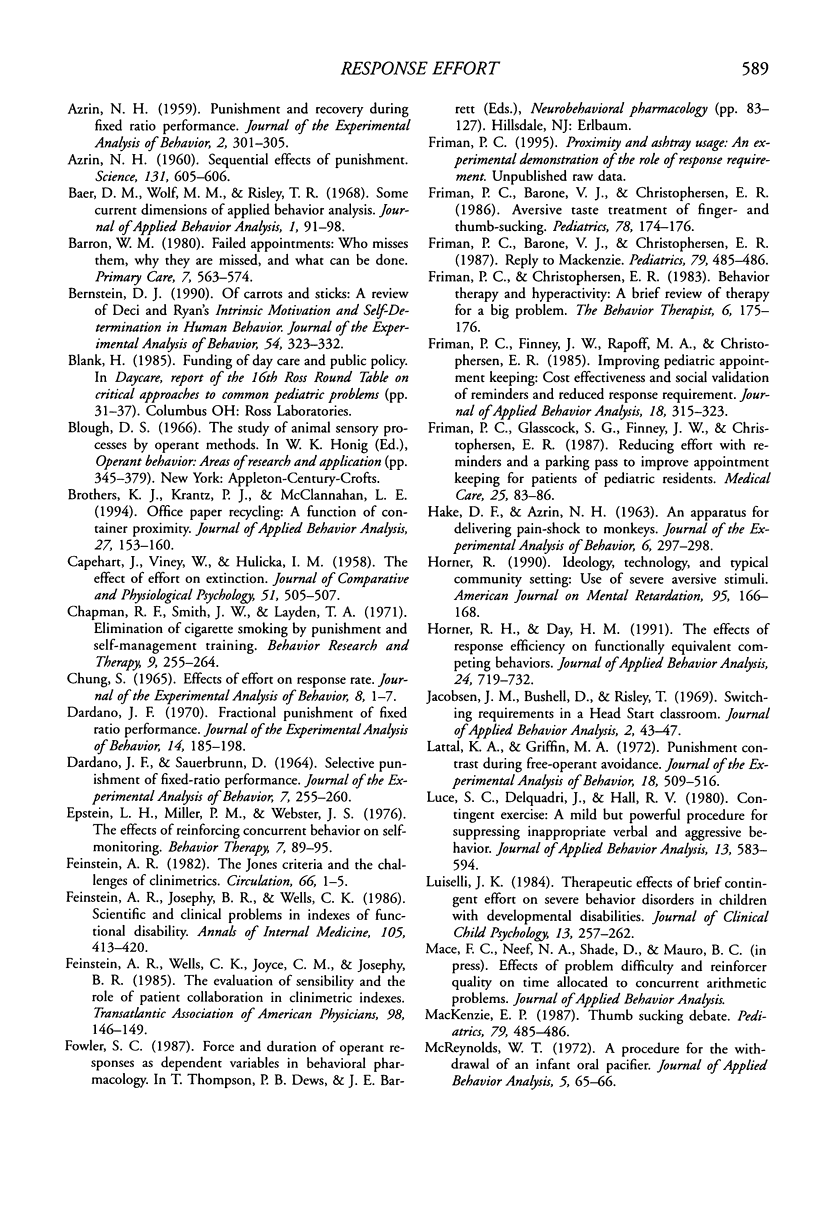
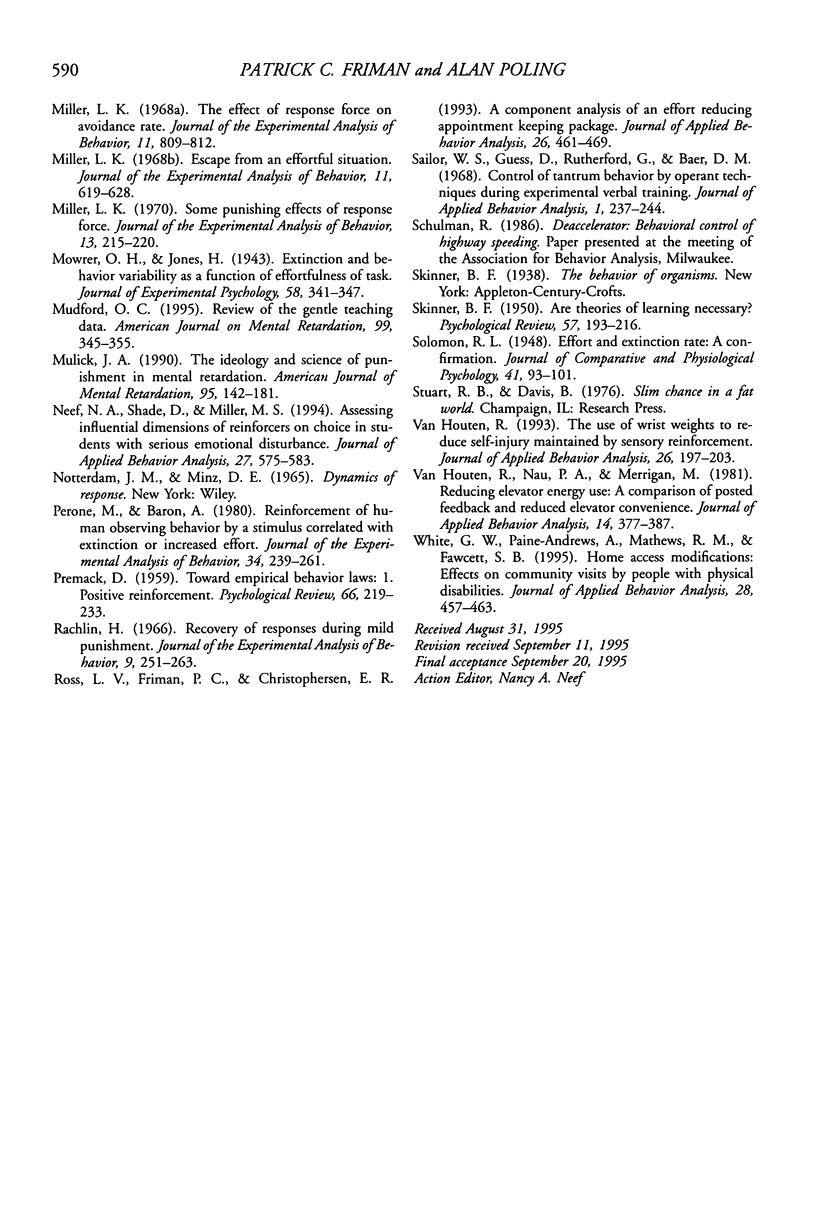
Selected References
These references are in PubMed. This may not be the complete list of references from this article.
- AZRIN N. H. Punishment and recovery during fixed-ratio performance. J Exp Anal Behav. 1959 Oct;2:301–305. doi: 10.1901/jeab.1959.2-301. [DOI] [PMC free article] [PubMed] [Google Scholar]
- AZRIN N. H. Sequential effects of punishment. Science. 1960 Feb 26;131(3400):605–606. doi: 10.1126/science.131.3400.605. [DOI] [PubMed] [Google Scholar]
- Adair E. R., Wright B. A. Behavioral thermoregulation in the squirrel monkey when response effort is varied. J Comp Physiol Psychol. 1976 Feb;90(2):179–184. doi: 10.1037/h0077197. [DOI] [PubMed] [Google Scholar]
- Alling K., Poling A. The effects of differing response-force requirements on fixed-ratio responding of rats. J Exp Anal Behav. 1995 May;63(3):331–346. doi: 10.1901/jeab.1995.63-331. [DOI] [PMC free article] [PubMed] [Google Scholar]
- Baer D. M., Wolf M. M., Risley T. R. Some current dimensions of applied behavior analysis. J Appl Behav Anal. 1968 Spring;1(1):91–97. doi: 10.1901/jaba.1968.1-91. [DOI] [PMC free article] [PubMed] [Google Scholar]
- Barron W. M. Failed appointments. Who misses them, why they are missed, and what can be done. Prim Care. 1980 Dec;7(4):563–574. [PubMed] [Google Scholar]
- Brothers K. J. Office paper recycling: A function of container proximity. J Appl Behav Anal. 1994 Spring;27(1):153–160. doi: 10.1901/jaba.1994.27-153. [DOI] [PMC free article] [PubMed] [Google Scholar]
- CAPEHART J., VINEY W., HULICKA I. M. The effect of effort upon extinction. J Comp Physiol Psychol. 1958 Aug;51(4):505–507. doi: 10.1037/h0045753. [DOI] [PubMed] [Google Scholar]
- CHUNG S. H. EFFECTS OF EFFORT ON RESPONSE RATE. J Exp Anal Behav. 1965 Jan;8:1–7. doi: 10.1901/jeab.1965.8-1. [DOI] [PMC free article] [PubMed] [Google Scholar]
- Chapman R. F., Smith J. W., Layden T. A. Elimination of cigarette smoking by punishment and self-management training. Behav Res Ther. 1971 Aug;9(3):255–264. doi: 10.1016/0005-7967(71)90011-8. [DOI] [PubMed] [Google Scholar]
- DARDANO J. F., SAUERBRUNN D. SELECTIVE PUNISHMENT OF FIXED-RATIO PERFORMANCE. J Exp Anal Behav. 1964 May;7:255–260. doi: 10.1901/jeab.1964.7-255. [DOI] [PMC free article] [PubMed] [Google Scholar]
- Dardano J. F. Fractional punishment of fixed-ratio performance. J Exp Anal Behav. 1970 Sep;14(2):185–198. doi: 10.1901/jeab.1970.14-185. [DOI] [PMC free article] [PubMed] [Google Scholar]
- Feinstein A. R., Josephy B. R., Wells C. K. Scientific and clinical problems in indexes of functional disability. Ann Intern Med. 1986 Sep;105(3):413–420. doi: 10.7326/0003-4819-105-3-413. [DOI] [PubMed] [Google Scholar]
- Feinstein A. R. T. Duckett Jones Memorial Lecture. The Jones criteria and the challenges of clinimetrics. Circulation. 1982 Jul;66(1):1–5. doi: 10.1161/01.cir.66.1.1. [DOI] [PubMed] [Google Scholar]
- Feinstein A. R., Wells C. K., Joyce C. M., Josephy B. R. The evaluation of sensibility and the role of patient collaboration in clinimetric indexes. Trans Assoc Am Physicians. 1985;98:146–149. [PubMed] [Google Scholar]
- Friman P. C., Barone V. J., Christophersen E. R. Aversive taste treatment of finger and thumb sucking. Pediatrics. 1986 Jul;78(1):174–176. [PubMed] [Google Scholar]
- Friman P. C., Finney J. W., Rapoff M. A., Christophersen E. R. Improving pediatric appointment keeping with reminders and reduced response requirement. J Appl Behav Anal. 1985 Winter;18(4):315–321. doi: 10.1901/jaba.1985.18-315. [DOI] [PMC free article] [PubMed] [Google Scholar]
- Friman P. C., Glasscock S. G., Finney J. W., Christophersen E. R. Reducing effort with reminders and a parking pass to improve appointment keeping for patients of pediatric residents. Med Care. 1987 Jan;25(1):83–86. doi: 10.1097/00005650-198701000-00010. [DOI] [PubMed] [Google Scholar]
- HAKE D. F., AZRIN N. H. An apparatus for delivering pain shock to monkevs. J Exp Anal Behav. 1963 Apr;6:297–298. doi: 10.1901/jeab.1963.6-297. [DOI] [PMC free article] [PubMed] [Google Scholar]
- Horner R. H., Day H. M. The effects of response efficiency on functionally equivalent competing behaviors. J Appl Behav Anal. 1991 Winter;24(4):719–732. doi: 10.1901/jaba.1991.24-719. [DOI] [PMC free article] [PubMed] [Google Scholar]
- Houten R. V., Nau P. A., Merrigan M. Reducing elevator energy use: A comparison of posted feedback and reduced elevator convenience. J Appl Behav Anal. 1981 Winter;14(4):377–387. doi: 10.1901/jaba.1981.14-377. [DOI] [PMC free article] [PubMed] [Google Scholar]
- Jacobson J. M., Bushell D., Risley T. Switching requirements in a Head Start classroom. J Appl Behav Anal. 1969 Spring;2(1):43–47. doi: 10.1901/jaba.1969.2-43. [DOI] [PMC free article] [PubMed] [Google Scholar]
- Lattal K. A., Griffin M. A. Punishment contras during free-operant avoidance. J Exp Anal Behav. 1972 Nov;18(3):509–516. doi: 10.1901/jeab.1972.18-509. [DOI] [PMC free article] [PubMed] [Google Scholar]
- Luce S. C., Delquadri J., Hall R. V. Contingent exercise: a mild but powerful procedure for suppressing inappropriate verbal and aggressive behavior. J Appl Behav Anal. 1980 Winter;13(4):583–594. doi: 10.1901/jaba.1980.13-583. [DOI] [PMC free article] [PubMed] [Google Scholar]
- MacKenzie E. P. Thumb-sucking debate. Pediatrics. 1987 Mar;79(3):485–486. [PubMed] [Google Scholar]
- MacKenzie E. P. Thumb-sucking debate. Pediatrics. 1987 Mar;79(3):485–486. [PubMed] [Google Scholar]
- McReynolds W. T. A procedure for the withdrawal of an infant oral pacifier. J Appl Behav Anal. 1972 Spring;5(1):65–66. doi: 10.1901/jaba.1972.5-65. [DOI] [PMC free article] [PubMed] [Google Scholar]
- Miller L. K. Escape from an effortful situation. J Exp Anal Behav. 1968 Sep;11(5):619–627. doi: 10.1901/jeab.1968.11-619. [DOI] [PMC free article] [PubMed] [Google Scholar]
- Miller L. K. Some punishing effects of response-force. J Exp Anal Behav. 1970 Mar;13(2):215–220. doi: 10.1901/jeab.1970.13-215. [DOI] [PMC free article] [PubMed] [Google Scholar]
- Miller L. K. The effect of response force on avoidance rate. J Exp Anal Behav. 1968 Nov;11(6):809–812. doi: 10.1901/jeab.1968.11-809. [DOI] [PMC free article] [PubMed] [Google Scholar]
- Mudford O. C. Review of the gentle teaching data. Am J Ment Retard. 1995 Jan;99(4):345–355. [PubMed] [Google Scholar]
- Mulick J. A. The ideology and science of punishment in mental retardation. Am J Ment Retard. 1990 Sep;95(2):142–181. [PubMed] [Google Scholar]
- Neef N. A., Shade D., Miller M. S. Assessing influential dimensions of reinforcers on choice in students with serious emotional disturbance. J Appl Behav Anal. 1994 Winter;27(4):575–583. doi: 10.1901/jaba.1994.27-575. [DOI] [PMC free article] [PubMed] [Google Scholar]
- doi: 10.1901/jeab.1990.54-323. [DOI] [PMC free article] [Google Scholar]
- PREMACK D. Toward empirical behavior laws. I. positive reinforcement. Psychol Rev. 1959 Jul;66(4):219–233. doi: 10.1037/h0040891. [DOI] [PubMed] [Google Scholar]
- Perone M., Baron A. Reinforcement of human observing behavior by a stimulue correlated with extinction or increased effort. J Exp Anal Behav. 1980 Nov;34(3):239–261. doi: 10.1901/jeab.1980.34-239. [DOI] [PMC free article] [PubMed] [Google Scholar]
- Rachlin H. Recovery of responses during mild punishment. J Exp Anal Behav. 1966 May;9(3):251–263. doi: 10.1901/jeab.1966.9-251. [DOI] [PMC free article] [PubMed] [Google Scholar]
- Ross L. V., Friman P. C., Christophersen E. R. An appointment-keeping improvement package for outpatient pediatrics: systematic replication and component analysis. J Appl Behav Anal. 1993 Winter;26(4):461–467. doi: 10.1901/jaba.1993.26-461. [DOI] [PMC free article] [PubMed] [Google Scholar]
- SKINNER B. F. Are theories of learning necessary? Psychol Rev. 1950 Jul;57(4):193–216. doi: 10.1037/h0054367. [DOI] [PubMed] [Google Scholar]
- Sailor W., Guess D., Rutherford G., Baer D. M. Control of tantrum behavior by operant techniques during experimental verbal training. J Appl Behav Anal. 1968 Fall;1(3):237–243. doi: 10.1901/jaba.1968.1-237. [DOI] [PMC free article] [PubMed] [Google Scholar]
- Van Houten R. The use of wrist weights to reduce self-injury maintained by sensory reinforcement. J Appl Behav Anal. 1993 Summer;26(2):197–203. doi: 10.1901/jaba.1993.26-197. [DOI] [PMC free article] [PubMed] [Google Scholar]
- White G. W., Paine-Andrews A., Mathews R. M., Fawcett S. B. Home access modifications: effects on community visits by people with physical disabilities. J Appl Behav Anal. 1995 Winter;28(4):457–463. doi: 10.1901/jaba.1995.28-457. [DOI] [PMC free article] [PubMed] [Google Scholar]


